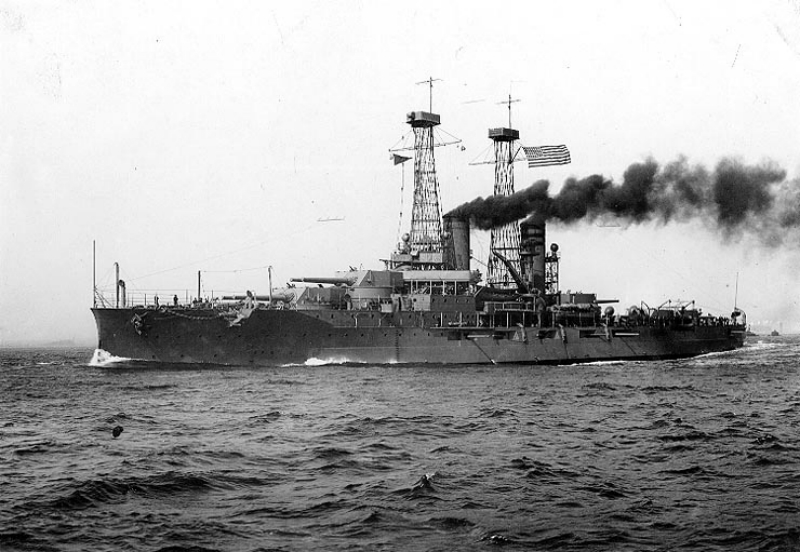

Benjamin F. Armstrong, 21st Century Sims: Innovation, Education, and Leadership for the Modern Era (Naval Institute Press, 2015)
William Sims is one of the most underrated officers and strategists in the history of the United States Navy, and arguably the American military as a whole. Many are, of course, familiar with the writings of Alfred Mahan, the most famous strategist in the history of the United States Navy. Many fewer know that Mahan’s intellectual swan song, so to speak, happened when Sims soundly defeated Mahan in a debate in the pages of Proceedings, a magazine published by the U.S. Naval Institute, over the all-big-gun battleship in 1906.
Throughout his career, Sims made a significant difference in ways that positively influenced the ability of the U.S. Navy to fight and win wars. Early on, Sims, drawing on the ideas of British naval innovator Percy Scott, brought the new continuous fire method, which used an elevating gear and new sights to allow gunners to aim and fire constantly, rather than just as the waves rolled, to the United States Navy. This dramatically improving the ability of the Navy to accurately target and hit enemy ships. Sims then helped lead the charge for the Navy to adopt the best battleship design of the period – the all-big-gun battleship. Eliminating smaller-caliber guns and switching to all-large-caliber guns meant these battleships offered navies significantly greater striking power than the previous generation of ships. The U.S. Navy’s rapid adoption of modern battleship design helped it keep pace with the British and Germans and continue its rise in the early 20th century. Sent to lead American naval forces in Great Britain in World War I, Sims excelled at the task and then wrote a Pulitzer Prize-winning book, The Victory at Sea, about the Allied response to the U-boat campaign during the war. Finally, Sims led the Naval War College from 1919 until he retired in 1922, reforming its educational practices in ways that encouraged experimentation and tabletop gaming. These reforms created intellectual space for a generation of naval officers such as Chester Nimitz to figure out the best way to use new capabilities such as naval aviation and the submarine. It is no wonder that, at the time, Sims was considered a great innovator and naval leader.
In his new book, 21st Century Sims, USN Lieutenant Commander Benjamin F. Armstrong introduces this largely forgotten strategist to a new generation. In an accessible volume that builds on his prior work on Mahan, Armstrong introduces Sims to the reader, and then intersperses commentary with original writing from Sims for the rest of the book. This smart choice not only gives readers context to understand Sims’ ideas in their own time, along with potential applications today, but also lets Sims speak for himself.
This is an important book. Sims’ ideas, as explained below, and by Armstrong, are highly relevant for the challenges the U.S. military in general, and the Navy in particular, face today. Sims’ focus on military innovation, in particular, can both provide context for key strategy choices by the Navy in the early 20th century and useful insight and inspiration for future naval leaders seeking responsible ways to ensure that the U.S. Navy remains ahead.
Armstrong gives readers access to six of Sims’ written works:
Readers also will appreciate an article about Sims published a year after his death in 1936, written by Captain Harry Balbridge. Balbridge describes Sims as an “iconoclast,” focusing mostly on Sims’ intense efforts, as a junior officer facing strong career incentives to keep quiet, to reveal the Navy’s struggles with gunnery and design a new and improved system.
Armstrong’s commentary throughout the book is striking, well-written, and offers many relevant insights into critical issues facing the U.S. military today. In some ways, the book leaves the reader wanting to hear more about Armstrong’s own perspective. The advantage of this approach, as referenced above, is that it lets Sims speak for himself. Given that this is the primary purpose of the book, it accomplishes its mission extremely well. However, while the introductory essay is extremely useful, as are the introductions to each chapter, it would have been interesting to hear more from Armstrong at the end of the book about which of Sims’ lessons he views as most relevant for the U.S. Navy today. Perhaps this could be the subject of a future article or essay at War on the Rocks.
This book is highly recommended not just for those interested in naval strategy, but those interested in military strategy, military innovation, and civil-military relations more broadly. Sims occupies a unique place in history. He not only served in the U.S. Navy prior to the Spanish-American War, the conflict that demonstrated that the Navy had come of age on a global stage. He also served into the era of the airplane, where his writings directly shaped some of America’s most important future naval leaders, and he helped set in motion the war gaming and experimentation that led to America’s mastery of carrier warfare, one of the single greatest successes, from an innovation adoption perspective, in the history of naval warfare.
Michael C. Horowitz is an Associate Professor of Political Science at the University of Pennsylvania. You can follow him on Twitter: @mchorowitz.
